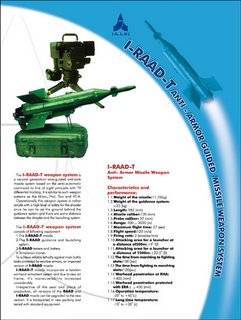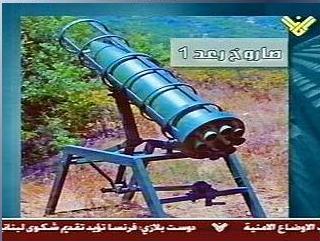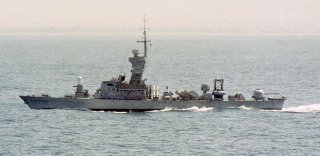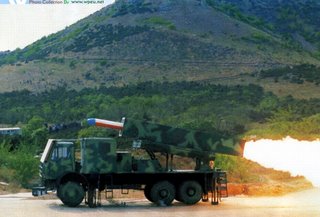A missile fired by Hezbollah, not an unmanned drone laden with explosives, damaged an Israeli warship off Lebanon, the army said Saturday.There is a great deal of media confusion over the sorts of missiles and rockets being used by Hezbollah, which is understandable in that Iran appears to have a number of missiles and rockets with the same name (see, for example, this). Bill Roggio at the CounterTerrorism Blog has more here, in which he suggests that the Israeli ship was struck by an anti-tank missile fired from a UAV. Israeli forces report that the ship was struck by a shore-based missile. In this case, I suspect that the latter report is correct.
The attack late Friday alarmed Israel because initial information indicated the guerrillas had used a drone for the first time to attack Israeli forces.
But the army's investigation showed that Hezbollah had fired an Iranian-made missile at the vessel from the shores of Lebanon, said Brig. Gen. Ido Nehushtan.
"We can confirm that it was hit by an Iranian-made missile launched by Hezbollah. We see this as very profound fingerprint of Iranian involvement in Hezbollah," Nehushtan said in an interview with The Associated Press.
Another Hezbollah missile also hit and sank a nearby merchant ship at around the same time, Nehushtan said. He said that ship apparently was Egyptian, but had no other information.


However, based on the photo at DefenceTech (second photo), I suspect that the RAAD involved in the ship attack was the wire-guided anti-armor missile
Iran makes a copy of the Russian AT-3 9M14M (Sagger or Ra’ad) anti-tank guided missile. An improved version of RAAD missile, RAAD-T missile, incorporates a tandem warhead armament system and due to new airframe, its maneuverability increased considerably. Irrespective of the year and place of production, all versions of RAAD missiles can be upgraded to the new version. The RAAD-T weapon system is a portable anti-tank guided missile, which is used to attack any armored fighting vehicle including those with Explosive Reactive Armor (ERA). In field operations, only by one ground guidance equipment, up to four missiles on their launchers can be shot, each in every 30 seconds. The system Safety and Arming Device (SAD) provides a high level of safety during the transportation and handling besides a reliable arming in operation. It is transported in new packing and tested with new equipment. By impacting the target, even at high angles of attack, explosion of the front charge, will remove the Explosive Reactive Armor (ERA) and after a delay time, the main charge will be exploded and the tank distrusted.This RAAD is a variation on the Russian Sagger AT-3 which has an effective range of up to 3000 meters.

If the Israeli ship was engaged in shore bombardment, it may have been that close to shore. My guess is that the damaged ship was not one of the SAAR-5 missile corvettes, but an older Hetz class equipped with a 76mm gun which has a maximum range of about 18,000 meters. In order to do shore bombardment, this class of ship would have to close to shore, probably within range of the anti-tank RAAD. I also doubt that the cruise missile RAAD was in play. Of course, I'm just guessing.
UPDATE: Fox News asserts that the ship was a SAAR-5 and the missile was a "radar-guided C-102":
The army would not confirm if the ship was arriving, but the Saar 5-class missile ship, named the "Spear," could clearly be seen on television sailing into port.I can't find a C-102 missile, but Iran did acquire some C-802 missiles from China. This missiles can be sea or land launched (see photo), but given their profile C-802 seem like a bit of overkill to me.
The ship was severely damaged Friday night after it was struck by an Iranian-made, radar-guided C-102 missile.
Cruise missiles are "much cheaper to build than ballistic missiles, do not present the problem of high reentry velocities, and can strike a specific target within 10-20 meters." Their introduction with terminal command guidance promises to make Iranian biological and chemical weapons even more usable.35 Iran reportedly possesses the HY-2 Silkworm cruise missile, and China is reported to have built a plant in Iran to assemble the Silkworm. China is also reportedly helping the IRGC to increase the Silkworm's range to over 400 kilometers36. There is also evidence that Iran is deploying the Chinese C802 antiship cruise missile. The C802 has a 120-km range with an "adequate guidance system and a 700-km warhead." It's serious weapon, but I would be very surprised if Iran were crewing some on the Lebanon coast.

UPDATE2: StrategyPage has a nice chart of Iranian artillery rockets here. Note that the Shahin-1 is a multi-nozzled rocket like the image capture above.
UPDATE3: Commenter Sid offers up some more info in the comment section. He argues SAAR-5 (and has good reason to do so) also points to an Iranian manned C-802 launcher in West Beirut. His take may well be right. Feel free to join in the discussion.
UPDATE4: Color me surprised. Latest FoxNews TV report asserts "Chinese designed, Iranian made missile" and says Israel asserts Hezbollah would require help from Iranians to make it work. More as it breaks.
UPDATE5: Truck mounted double box launcher for the C-802. Could explain firing on two ships in same area. Probably easy to hide and make look like an cargo truck until firing time, which, in the video provided by Sid, seems to have been night so that prying overhead eyes might just observe a truck until the last minute. Photo from a Chinese language site.

UPDATE6: An earlier post that features the C-701 and a Iranian truck mounted box launcher.
 Note the commericial looking front end.
Note the commericial looking front end.UPDATE7: C-802 mentioned here by Navy spokesman. SAAR-5 Corvette:

UPDATE8: THe CounterTerrorism Blog has a new post on the missile attack here and points to a C-802.

No comments:
Post a Comment